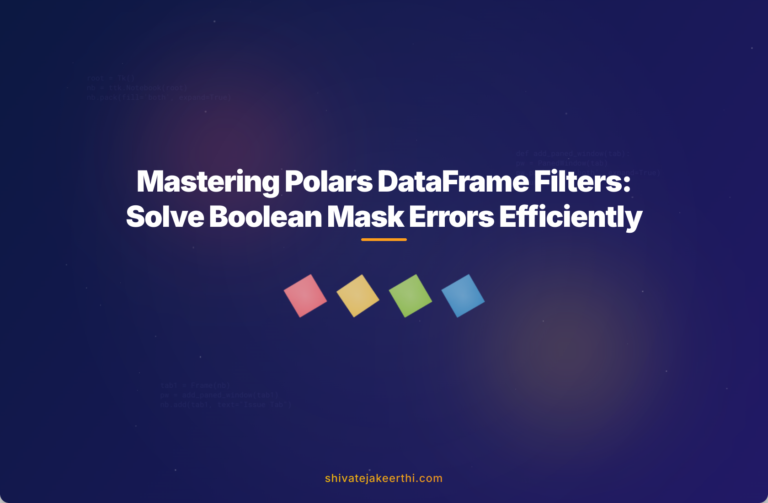Filtering rows in your Polars DataFrame using a boolean mask can seem straightforward if you’re familiar with libraries like Pandas. However, users moving to Polars often encounter unexpected errors when attempting familiar methods for row filtering. Let’s clearly understand what’s happening behind the scenes, explore the correct approach, and discover a practical workaround.
What is Polars DataFrame?
Polars is a high-performance, easy-to-use DataFrame library built especially for working with large datasets efficiently. It’s popular among developers who deal with huge data workloads due to its lightning-fast operations and minimal memory usage.
Compared to the popular Pandas DataFrame, Polars offers some highly desirable improvements, especially speed and scalability. While both libraries share similar APIs, their approach and functionality under the hood differ significantly. For example, in Pandas, filtering rows by using a boolean mask is typically as simple as:
import pandas as pd
data = {'name': ['Alice', 'Bob', 'Charlie', 'David'],
'age': [25, 30, 22, 35]}
df = pd.DataFrame(data)
# Boolean mask filtering in Pandas
bool_mask = df['age'] > 25
filtered_df = df[bool_mask]
print(filtered_df)
However, trying a similar approach in Polars, like directly applying a boolean mask as an index, will lead you to encounter errors that initially seem puzzling.
Why Does Polars Throw an Error with Boolean Masks?
Suppose you try filtering rows in Polars using the Pandas-like syntax. You would probably write something like this:
import polars as pl
data = {'name': ['Alice', 'Bob', 'Charlie', 'David'],
'age': [25, 30, 22, 35]}
df = pl.DataFrame(data)
# Attempted boolean indexing (Pandas-style approach)
bool_mask = df['age'] > 25
filtered_df = df[bool_mask] # This line throws an error
print(filtered_df)
Sadly, this code snippet will raise an error, typically along the lines of:
TypeError: 'DataFrame' object is not callable or subscriptable with a boolean mask
Unlike Pandas, Polars doesn’t support direct boolean indexing. It’s crucial to recognize this difference early to avoid being stuck troubleshooting the error message. The main reason is Polars prefers explicit functions or methods tailored to specific tasks for expression-based filtering.
Digging into Polars API Documentation
According to the official Polars documentation, the recommended way to filter DataFrame rows is to use the dedicated .filter() method or explicit expressions rather than boolean indexing.
However, sometimes you might want or need alternatives, especially if you’d like to avoid using the conventional .filter() method or SQL-based queries. It’s helpful in scenarios where you’re moving from Pandas-based code and want minimal refactoring, or when your boolean mask comes from external sources that expect a different handling.
Possible Alternatives—Using .filter or .sql
Polars provides two powerful methods to filter rows directly:
- .filter(): Uses Polars’ own query expressions to select rows conditionally. It’s fast, intuitive, and the officially preferred way.
- .sql(): Allows filtering using SQL syntax directly within your codebase, especially handy for users who enjoy writing SQL queries.
While these methods are officially recommended, some developers prefer more straightforward or universal approaches. But before we implement a workaround, let’s quickly evaluate these methods first.
Example with .filter()
Here’s how you’d implement row filtering using the .filter() method, which is the cleanest and easiest way:
filtered_df = df.filter(pl.col('age') > 25)
print(filtered_df)
It’s concise, readable, and easy to maintain.
Example with .sql
Polars has built-in support for SQL queries through the Polars SQLContext API. You can filter as follows:
ctx = pl.SQLContext()
ctx.register("people", df)
filtered_df = ctx.execute("""
SELECT * FROM people WHERE age > 25
""").collect()
print(filtered_df)
However, this method might be unnecessarily verbose for quick filtering tasks. It suits developers who strictly prefer SQL syntax within Python workflows.
Implementing a Simple Workaround (Without .filter or .sql)
If you genuinely aim to avoid explicit use of .filter() or .sql(), you can consider a practical workaround:
- Create your boolean mask explicitly as a Polars Boolean Series.
- Use Polars’ indexing capability —
.select()with.where()— to handle filtering effectively.
Here’s the step-by-step approach using .select() and .where():
# A practical workaround without filter or SQL
bool_mask = df['age'] > 25
filtered_df = df.select([
pl.all().where(bool_mask)
]).drop_nulls()
print(filtered_df)
This method directly applies the boolean mask to every column, returning rows where the condition is True and substituting nulls elsewhere. Dropping null rows at the end gives the desired filtering effect without explicitly using .filter().
Comparing Results in Practice
Here’s how the result looks in practice using this workaround:
shape: (2, 2)
┌───────┬─────┐
│ name ┆ age │
│ --- ┆ --- │
│ str ┆ i64 │
╞═══════╪═════╡
│ Bob ┆ 30 │
│ David ┆ 35 │
└───────┴─────┘
Comparing this output to the .filter() method, you’ll find the result is precisely the same. The effectiveness of the workaround is evident, especially for users migrating from Pandas-style boolean indexing.
Looking Ahead—Polars API Improvements
Given the common confusion from developers migrating from Pandas, it’s reasonable to hope Polars might introduce a simpler or more intuitive method for boolean indexing in future updates. The Polars community regularly contributes with feedback to improve usability and ease-of-adoption, which means community-driven suggestions could shape the next iterations of Polars API. (You can always follow active discussions or participate through Polars GitHub repository.)
References
- Official Polars Python Documentation
- Pandas Official Documentation
- Stack Overflow questions related to Polars
- Polars’ GitHub Repository
- Further Python-related articles
In short, filtering rows in Polars using boolean masks isn’t directly possible the Pandas way. But fortunately, Polars offers robust methods like .filter() or SQL querying. And as we’ve shown, even direct boolean masking, though not intuitive at first, is achievable through clever workarounds. Do you prefer this workaround or would you rather stick to officially recommended methods? Feel free to share your thoughts or questions below!



0 Comments